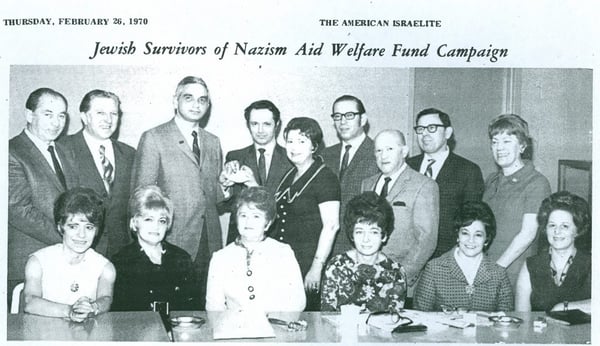No two Holocaust survivor stories are alike, says Cori Silbernagel, the curator of the Nancy and David Wolf Holocaust and Humanity Center. We can relate. No two storage solutions are the same either. Our custom design for the Cincinnati, Ohio, non-profit took the uniqueness of the project into account.
Museums and Humanity Centers like the facility we partnered with in Cincinnati face a unique challenge when it comes to storage. Much like any business, the goal of a curator is to grow the business. For them, this would consist of expanding their collection from all over the world.
Everyone has “stuff” that they need to be stored. But when the stuff you have is the last remaining artifacts that document human history, you need a storage solution that can also stand the test of time.
Museums, art centers and humanity centers all need storage that is durable enough to hold large collections but also keep the artifacts or products in perfect conditions. Luckily, Patterson Pope has customizable storage solutions that provide the durability, protection and organization to allow your “stuff” to stand the test of time.
Running Out of Time & Space
Founded in 2000, the Nancy and David Wolf Holocaust and Humanity Center (HHC) “exists to ensure the lessons of the Holocaust inspire action today.” The organization "educates about the Holocaust, remembers its victims and acts on its lessons…challenges injustice, inhumanity, and prejudice, and fosters understanding, inclusion, and engaged citizenship.”
From 2009-2019, the HHC was housed on the campus of a Jewish day school in Kenwood. The HHC flourished, and its collection grew. But the space was limited. Storage was not climate controlled, and the solutions were retrofitted to the available room. Plus there was no workspace. According to HCC curator Cori Silbernagel, “it was not ideal.”
Then the HHC was given the opportunity to move into a prestigious historic building in Cincinnati. The Union Terminal is, in fact, the train station where many of the city’s Holocaust survivors may initially have arrived. The relocation provided an opportunity to raise awareness, but it also represented a big change for the collections storage.
In making decisions in designing the new storage and workspace for the HHC’s artifacts, the team faced a tight timeline, budget restraints and awareness that this is “a really critical time in the history of Holocaust education.” Silbernagel explained, “We’re among our last generation of survivors. So, collection care and preservation and access are critical right now for us.”
“This is the time when we can help document their stories before the names are lost to history or parts of the story don’t get passed down,” she said.
Silbernagel had worked with Patterson Pope in the past but never on a design for a new collections storage space. She knew that she needed compact shelving, art racks, oversized storage and flat files, and she felt it was great to have Patterson Pope to pull it all together and collaborate with the different designers involved in the HHC build-out.
Unique, Fragile Collections
The collections at the HHC preserve artifacts from before, during and after the Holocaust. Each item helps tell a story. Perhaps a survivor now living in Cincinnati. Or a family member of a survivor. Or military veterans who served in Germany. Or Americans living abroad in Germany during World War II.
Everything from a prisoner’s hat from Auschwitz to a certificate that indicates a survivor took an American citizenship course in a Cincinnati public library is collected by the HHC. First-hand stories are “so integral to everything we do at the Center,” said Silbernagel. And the wide variety of items in the HHC’s collections are “the vehicles of storytelling.”

Presented with new space that was basically “a blank box,” Silbernagel enjoyed being able to daydream with Patterson Pope’s designers about what the new space could look like. “We care for really fragile things that needed a specific environment to come to,” she said.
Plus, the organization had to plan for future growth. With artifacts coming in from all different sources, and in all different shapes, sizes and materials, the goal was designing a space to accommodate the current items and plan for the future, said Patterson Pope’s Gordon Kwiecinski.
Now, the center has a new space fit for what it already has and with room to continue adding to its collections. The design is complete with accessible space for HHC staff to work, so the education and preservation of people’s stories can continue uninterrupted.
The move to Union Terminal, Silbernagel said, “put our organization in a position to gain attention and increase access for our community to hear and see the stories we held.”
The HHC today impacts more than 180,000 individuals each year. Now in its new space, the HHC has enjoyed a positive reaction from the community and is thriving as a cultural hub.

Patterson Pope is proud of its work to support the organization’s efforts to raise awareness and educate about anti-semitism. Still, this is only one of many examples of our team working with unique collections to provide better access, best use of available space and help preserve and protect important items. See what we did aboard the USS Yorktown, in the UCF’s fine art gallery vault or learn about the varied solutions for the artifacts from the HL Hunley.
Preserving your stuff for the future is what we do best. Contact one of our salespeople today!
Silberman’s Advice for Other Collection Curators
“We worked as hard and as fast as we could. I would recommend beginning planning as early as you can. The more planning you do the more you can do it the right way and meet your mission. Ensure that you are checking off all the boxes and create the best space possible. The more time the better.”










